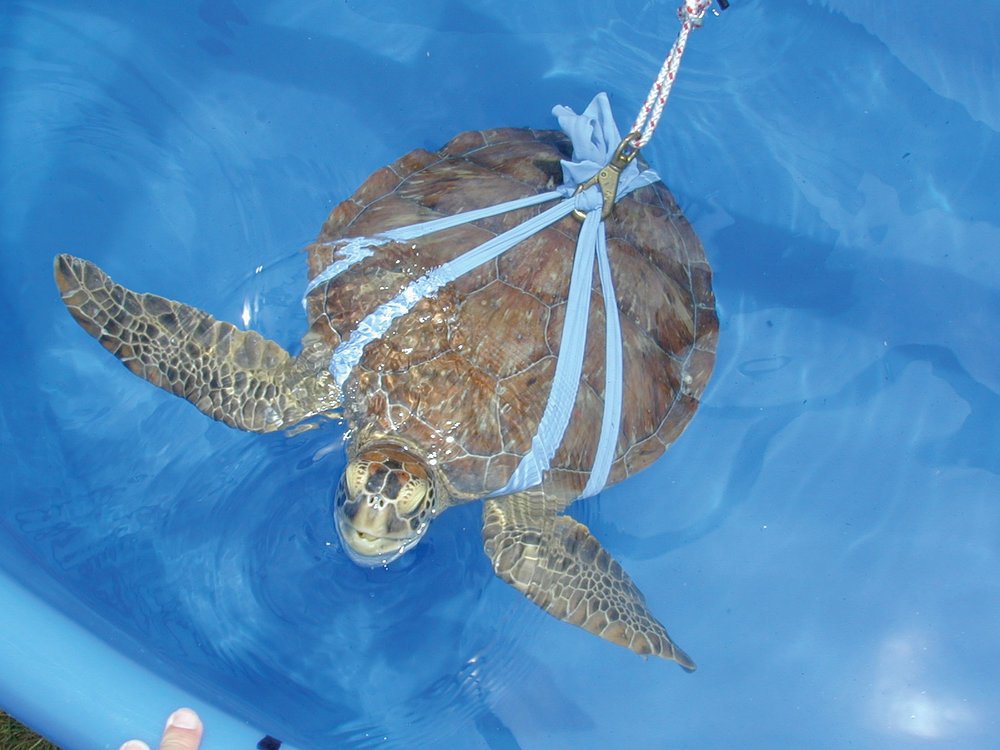The Mystery of Getting Where They Need to Go: How do sea turtles navigate?
By Kenneth J. Lohmann
A juvenile green turtle in a cloth harness is tethered to an electronic tracking system inside a magnetic coil. This methodology is used for magnetic navigation studies. © KENNETH J. LOHMANN
The long-distance migrations of sea turtles involve some of the most remarkable feats of orientation and navigation in the animal kingdom. As hatchlings, turtles chart unerring courses toward the open sea and maintain course even beyond sight of land. Juvenile turtles often follow complex migratory pathways that lead across entire ocean basins and back. As adults, turtles migrate from their feeding grounds, to specific mating and nesting areas, and back again to the feeding grounds. How turtles migrate so precisely and consistently across vast distances in the seemingly featureless ocean is among the most longstanding mysteries of sea turtle biology—a mystery that scientists are only now beginning to solve.
Considerable progress has been made in understanding the cues that guide hatchling turtles from their nests to the open ocean. Florida loggerhead hatchlings appear to use three sets of cues in sequence. After emerging from their nests, they find the ocean using visual cues. In the sea, they establish offshore headings by swimming directly into oncoming waves, which in shallow water move directly toward shore and reliably lead the turtles seaward. Farther out to sea, where waves may move in any direction relative to the shoreline, the turtles switch to using Earth’s magnetic field to guide themselves in much the same way that we use a magnetic compass to steer ourselves north or south.
In the open ocean, turtles add still another navigational trick: they use Earth’s magnetic field not only as a compass, but also as a source of information about where they are. Earth’s field varies in such a way that each oceanic region has a unique magnetic field associated with it. Turtles detect these subtle differences and follow inborn instructions that tell them how to respond to each field and, thus, in which direction to swim at different locations along the migratory route.
Juvenile turtles living in coastal feeding grounds also use Earth’s magnetic field in navigation. They apparently learn the magnetic landscape of the areas in which they live and use this information as a kind of magnetic map to guide them to particular destinations. Unraveling the organization, capabilities, and limitations of this remarkable magnetic navigational system will be an exciting area of research in coming years.
Many questions about sea turtle navigation remain. For example, do turtles use environmental cues other than ocean wave direction and Earth’s magnetic field in navigation? Although many navigational cues have been discussed—including chemical cues, visual landmarks (such as mountains along a coast), features of the underwater landscape, oceanic temperature gradients, and low-frequency sounds (caused, for example, by waves breaking on distant islands)—there is no clear evidence that turtles use any of these.
And how do adult turtles navigate back to their natal beaches? It is possible that they imprint on the magnetic signature of the home region, but whether they imprint on any aspect of the natal beach, magnetic or otherwise, remains an important mystery to be investigated.
Finally, to what extent is the migratory route of a young turtle inflexibly hardwired into its genes? Loggerhead hatchlings from Florida appear programmed to steer along a set course by recognizing and responding to magnetic fields characteristic of specific geographic locations. If these responses have a genetic basis, then populations that follow different migratory routes presumably inherit different responses to different regional fields. If so, attempts to reestablish an extinct nesting population by transplanting hatchlings from one location to another would fail, if the normal migratory route of the introduced turtles differs significantly from that of the extinct group. An improved understanding of sea turtle navigation will clearly assist efforts to protect and restore sea turtle populations throughout the world.
This article originally appeared in SWOT Report, vol. 2 (2007). Click here to download the entire article as a PDF.

